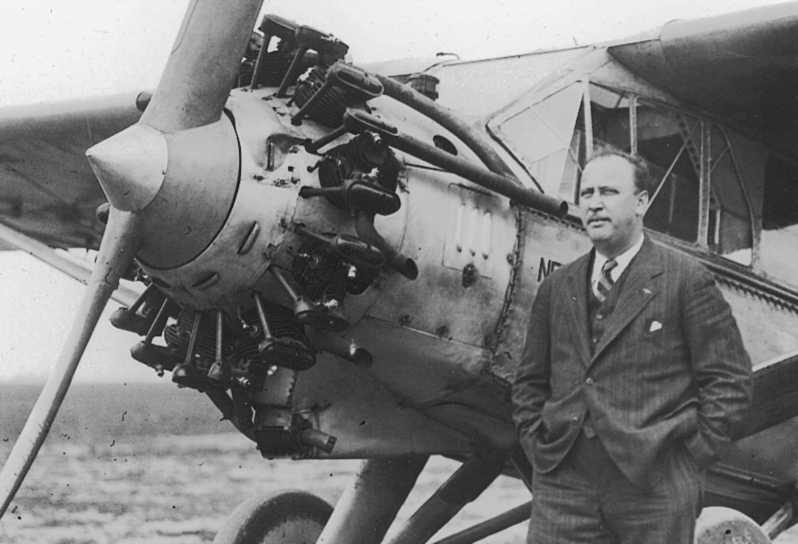When Erroll Boyd made his flight to London in 1930, he was the first to cross the North Atlantic outside the summer season.
Captain Erroll Boyd gunned the motor of his 5-year-old Bellanca monoplane Columbia to full power on the rough strip at Harbour Grace, Newfoundland, on October 9, 1930. At first she would not budge. The plane was heavily laden with fuel, causing the tail skid to sink into the rocky runway and act as a brake. Such was the unspectacular start of the first successful flight outside the summer season across the North Atlantic Ocean–already a graveyard for many pioneer aviators.
Earlier flights, by John Alcock and Arthur Whitten Brown, Charles Lindbergh, Clarence Chamberlain, and Richard Byrd, had been made under summer conditions, which had the advantages of better weather and fewer hours of darkness. Even in the best of conditions, it was a hazardous flight. Lindbergh would say in 1933, while surveying the route for Juan Trippe, head of Pan American Airways, ‘The North Atlantic is the most important, and also the most difficult to fly, of all the oceans crossed by the trade routes of men.’
Erroll Boyd, born in Toronto in 1891, flew for the first time in 1912, as a passenger with American barnstormer Lincoln Beachey. Boyd enjoyed the experience so much that he decided on a career in aviation. When World War I broke out in 1914, no air training schools existed in Canada. Like his father before him, Erroll Boyd joined the army–but he still wanted to fly. He went to England at family expense in early 1915 to enlist in the Royal Flying Corps, but he flunked the entrance exam because he was colorblind. He had more luck with the fledgling Royal Naval Air Service (RNAS), which had been formed by Winston Churchill, then the first lord of the Admiralty.
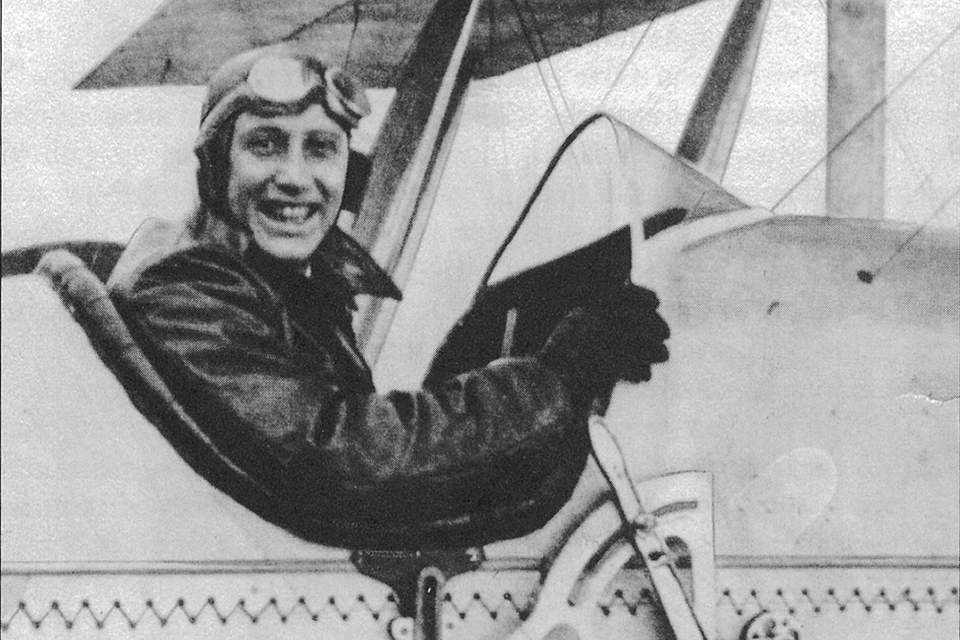
Alcock, who later gained fame with Brown in 1919 for the first nonstop Atlantic crossing, taught Boyd to fly at the naval base at Eastchurch on the Isle of Sheppey, near the mouth of the Thames River. Boyd made his first training flight in a Wright biplane that used wing warping for lateral control. After piloting a Short pusher, Boyd graduated, gaining Aero Club license No. 1358. Shortly thereafter he was assigned as a night pilot, ordered to destroy German zeppelins. At that time RNAS aircraft carried no guns. They were supposed to climb directly above the zeppelins and drop their small bombs on them, hoping to ignite and explode the hydrogen-filled airships.
The zeppelins started raiding England in early 1915, but their crews had instructions not to bomb the royal palaces occupied by the kaiser’s relatives. Zeppelins were hard to navigate, and their crews were very worried about anti-aircraft fire. As a result, they usually flew on moonless nights at high altitude.
Boyd later recalled his first zeppelin encounter near Eastchurch. The airship had dropped a few bombs on the airfield, cratering the runway. While Boyd was trying to take off in a Bristol biplane with a 50-hp Gnôme motor, he hit a bomb crater and turned over. Luckily the four 20-pound bombs he had been carrying did not explode, and he was given a second plane, a new 80-hp Avro, in which to pursue the marauder. Boyd was unable to get above 4,500 feet, however, and he could only watch as the zeppelin dropped ballast and easily escaped. In fact, Boyd never succeeded in getting above that or any other airship.
Aviation writer C.G. Grey, who condemned the practice of chasing airships with aircraft in the dark, criticized Churchill’s promise that any hostile airships would be ‘met by a swarm of hornets’ to provide an unpleasant welcome for the raiders. In 1916 a government report confirmed Grey’s opinion. In 89 flights, 20 British aircraft were partly or wholly wrecked. Clearly, zeppelin-chasing was a risky business. William A. ‘Billy’ Bishop, Canada’s top ace in the war, got the job of chasing zeppelins as his first assignment after gaining his wings in November 1916. Operating out of Northolt, he hated the work, describing the experience as like being tossed into a lake at midnight.
Boyd soon transferred across the English Channel to No. 1 Wing at Dunkirk, France. While stationed there he bombed a submarine, but the Germans later claimed it had not been lost. During an October 3, 1915, bomb raid over German-occupied Zeebrugge, Belgium, Boyd’s Robert Esnault-Pelterie R.E.P. Parasol was hit by anti-aircraft fire when he was flying at over 12,000 feet. He glided to a crash landing in neutral Holland, where he was subsequently interned.
Boyd eventually was allowed to live in The Hague and given considerable freedom. At one point he met New York World reporter Joseph J. O’Neill in a bar, and O’Neill later wrote a feature story about the Canadian pilot’s war experiences and his ambition to fly the Atlantic. Boyd knew all about English Lieutenant John Cyril Porte’s plans to cross the Atlantic in the seaplane America, built by Glenn Curtiss. The war had intervened, however, and the flight had not been made.
The Dutch later allowed Boyd to return to North America on medical grounds. After returning, he married a beautiful dancer, Evelyn Carberry, in New York City. Her friend, singer Al Jolson, hosted a big party for the newlyweds. Boyd subsequently wrote a popular war song, ‘For Love of Liberty,’ which was published in New York. He also became a test pilot, frequently traveling to Buffalo to test Curtiss JN-4 training planes.
Boyd was involved in a serious accident on July 1, 1917 at Mitchell Field, Mineola, Long Island, while testing the Lanzius I, an early all-metal welded plane. On its first test flight Boyd could not maintain lateral control and crashed. His seat belt broke and he was thrown clear of the plane. When rescuers arrived, Boyd was standing near the wreckage, casually smoking a cigarette. For a few days thereafter, he suffered from the effects of a minor concussion.
After the war ended, Boyd was managing a car rental firm in Toronto when one of his songs, ‘Dreams,’ became a hit on Broadway. He moved back to New York, where he even tried a little skywriting to publicize his songs. He later became manager for a British marmalade firm in Detroit, where he flew his own Waco biplane.
Charles Lindbergh’s successful solo flight across the Atlantic in May 1927 inspired Boyd to return to flying as a career. He tried unsuccessfully to convince his firm to finance a plane capable of a nonstop solo flight from New York to Moscow. He had done some test flying for Eddie Stinson from Stinson’s aircraft factory in Northville, Mich., and he hoped to acquire a plane from him. No luck. Boyd next took on the temporary job of flying the mail in Quebec province between Montreal and Rimouski, down the St. Lawrence River, for transfer to ocean liners going to and from England. Although a brief assignment, it rekindled his dream of becoming the first Canadian to fly the Atlantic Ocean.
Boyd later obtained a more permanent job with Mexicana Airline in Mexico in 1928, where he gained instrument flying experience. His ‘blind’ flying was done mostly in Fairchild 71s–flying without a radio and carrying a gross weight 400 pounds greater than that allowed in Canada. His most exciting check ride was with Mexicana chief pilot Eddie Snyder from Tampico on the coast to Mexico City and back, climbing through the mountains in very bad weather. Boyd subsequently was placed in charge of a new base at Merida, on Mexico’s Yucatan Peninsula. His Mexican instrument flying experience would prove invaluable during his North Atlantic crossing two years later.
Boyd moved back to New York in 1929 and took a supervisory flying position with Coastal Airways, which opened a popular floatplane service from the site of the present LaGuardia Airport to Albany. The airline later failed because of financial irregularities and accidents, even though it carried a record number of passengers that first summer.
In 1930 eccentric millionaire Charles A. Levine employed Boyd to pilot the Bellanca Columbia. Levine had crossed the Atlantic in it with pilot Clarence Chamberlain at the controls two weeks after Lindbergh’s 1927 flight. Levine, who loved being associated with glamorous pilots, also employed Bert Acosta, who had been the pilot for Richard Byrd’s Atlantic crossing in 1927, and Roger Q. Williams, who first flew from New York to Rome via Spain in 1929.
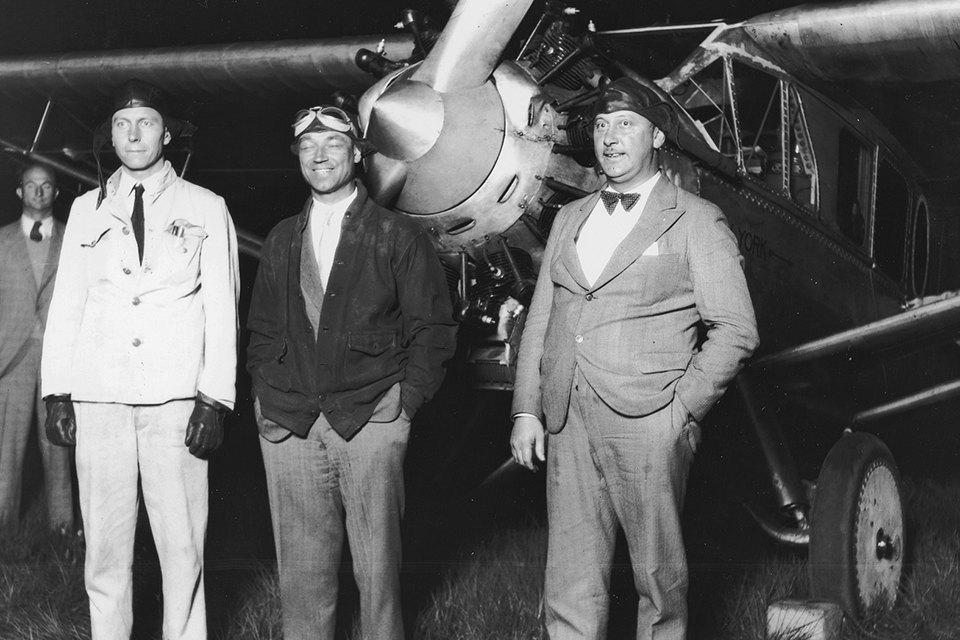
Wanting to fly to Bermuda, Boyd teamed up with Williams and navigator Harry Connor in the summer of 1930 to make a record nonstop flight in Columbia from New York to the island and back in 17 hours. Before their takeoff, spectators were placing odds of 5-to-1 that they would never be seen again. They were forced down to 400 feet by bad weather while nearing Bermuda, and the left magneto drowned out in a tropical downpour. They carried no radio, and Boyd at first thought they had flown right past the island without seeing it. He later wrote: ‘I was a little suspicious when Harry sent up a word to change course, stating we would arrive over Bermuda in ten minutes. At 2:23 we sighted the islands…Connor had a grin from ear to ear. This slim calculating naval officer had accomplished a navigational feat second to none.’ They flew over Bermuda below 200 feet and dropped mail on the island, which had no airport. Seven years later Imperial Airways and Pan American inaugurated scheduled flying-boat service to Bermuda.
Erroll Boyd now had complete confidence in Columbia as the aircraft that would be used for the first flight to Europe by a Canadian and the second solo flight after Lindbergh’s. He engaged a manager, Jack O’Brien, operator of a New York speakeasy, a hangout for famous aviators. O’Brien got Boyd a $10,000 contract from Hearst Publications for exclusive rights to flight coverage, to be paid following the flight’s completion.
They took Columbia to Toronto, where it was rechristened Maple Leaf, but–with the onset of the Great Depression–they failed to get much advance financial backing. When they landed back at St. Hubert Airport in Montreal, the Royal Canadian Mounted Police grounded the aircraft due to a claim by Williams that owner Levine owed him back pay. A three-week delay followed as bills piled up. Meanwhile, Connor was bombarding Boyd with letters arguing that it was too late in the season for a solo flight. Boyd finally agreed and invited the navigator to join him. Connor got a flight up to Montreal from New York with Bill Ulrich, who was later lost in an attempted flight to Rome. Connor brought with him a new Sperry artificial-horizon indicator that had recently been tested by James Doolittle.
Harry Connor turned up at the hotel in Montreal decked out in a new tweed suit with cane, gloves, shiny shoes and bow tie. Boyd and O’Brien were wearing wrinkled clothes and were reluctant to call the hotel valet for a pressing job because of their shaky finances. Boyd, realizing Connor had not been too flush in New York, said: ‘Harry, you must have hit the jackpot! Where did you get that outfit?’ The grinning Connor explained that he had visited the haberdashery in the hotel, outfitted himself and charged it to their room. How the charge escaped the credit manager’s notice was a mystery to Boyd and O’Brien.
A Montreal firm of lawyers finally got the aircraft released into Boyd’s custody. Some McGill University students then helped sneak the crew out the hotel’s service entrance. A soft-drink company underwrote their fuel from Montreal to Newfoundland, their planned oceanic jumping-off point.
Since Boyd and Connor were unable to reach the unlit landing strip in Harbour Grace in Newfoundland before nightfall, they landed in a farmer’s field near Charlottetown on Prince Edward Island. Bad weather delayed them there for another week. Once in Harbour Grace, they were advised of continuing poor weather and unusual easterly gales over the North Atlantic. Boyd carefully studied the rough-hewn runway where Captain John Henry Mears and his pilot, Harry Brown, had cracked up two months earlier during takeoff on their round-the-world attempt in their Lockheed Vega, City of New York.
The weather officials urged them to hold until the following spring, but they decided to fly early on October 9, when the forecasts and reports from ships at sea appeared to be as favorable as they could expect so late in the year. A heavy morning fog delayed takeoff until afternoon. When the moment came, Boyd gunned the engine to full power at the extreme eastern end of the runway, but the overloaded aircraft would not budge. The tail skid sank into the rocky runway, anchoring the Bellanca. Boyd throttled back, got out of the plane and instructed several onlookers how to push.
Boyd later said: ‘I had hoped for an earlier start, giving us the opportunity of using up at least 100 gallons of fuel before darkness, which would have lightened the plane some 600 pounds, making flying much easier during the long, dark hours ahead of us. With a heavy load the Bellanca tends to hunt and fall off on either wing, which would probably have sent the ship spinning into the Atlantic.’
They took off with 460 U.S. gallons (enough for about 35 hours of flying) and 27 gallons of oil; together they represented more than half of the aircraft’s gross weight of 5,200 pounds. They carried no radio, to save weight. To stress the routine nature of the trip, they were dressed in business clothes. Connor later wrote that he considered those 27 seconds during takeoff the hardest part of the whole flight.
The flight plan required flying close to the steamer route true east from St. John’s to 35 degrees west longitude, and then via the great-circle route to Swansea, Wales, and Bristol and Croydon in England. The weather was good for the first six hours, but against an average headwind of 20 mph their ground speed was only 72 mph. Vibrations on takeoff had rendered the earth-inductor compass dial unserviceable, so they had to rely on the two magnetic compasses.
An hour after dark, they experienced an electrical failure and had to use the emergency flashlight to energize the phosphoric material on the flight instruments. Later on, Boyd recalled: ‘Boy, it was dark! I felt as though I was piloting a car in a coal mine.’
Conditions deteriorated during the night. After encountering rain and rough air, they calculated by 0330 Universal time that they had reached 35 degrees west longitude, and changed their course northward as planned to follow the great-circle steamer route. While climbing through the clouds, they saw their outside temperature indicator drop to freezing. Boyd had painted a black strip on the wing’s leading edge and, with the aid of a flashlight, could see white particles of ice rapidly forming on the wing. He immediately descended and followed a southerly heading for some time, abandoning their planned track. Once they reached warmer temperatures, he climbed again into the clouds on an east-northeasterly course, calculated by dead reckoning.
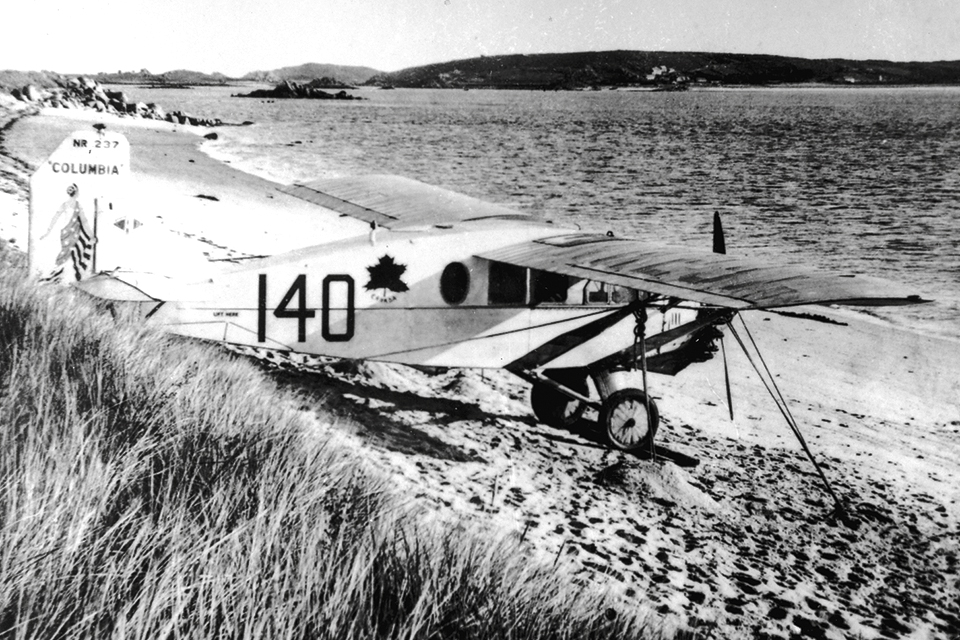
They came out of clouds at 12,000 feet. Boyd later recalled, ‘Believe me, that was the best moon I ever saw!’ Connor estimated their ground speed at 138 to 140 mph, although the airspeed indicated 90 to 92 mph. Accurate observations were impossible in those rough conditions, as they weaved between tremendous mountains of clouds. Since Connor was not a pilot, Boyd did all the flying. Whenever Boyd felt sleepy, Connor held a wet sponge soaked in ice water to the back of his neck.
After a long night of 10 1/2 hours, they were glad to see the dawn. They tried different altitudes to find smoother air. Connor finally determined their position at 47 degrees north latitude, 18 degrees west longitude–putting them 113 statute miles south of the steamer track. On their present course they were heading for the Bay of Biscay, so it was necessary to turn some 25 degrees northward toward Land’s End and London.
Because of aircraft noise, communication between Boyd and Connor was normally by written note. When Connor was shooting the sun, he would jerk a piece of string tied to the pilot’s wrist. One jerk meant he should change course 90 degrees to the right; a second jerk meant to reverse direction 180 degrees. That enabled Connor to get an accurate shot from two directions, the method used so successfully earlier on their Bermuda flight.
Trouble still loomed, however. They made the disconcerting discovery that because of a clogged line, the 100 gallons of fuel from the main reserve tank would not pump up into the gravity tank in the right wing–a problem they could not solve in the air. After pondering the risk of ditching near a passing ship, they decided they probably could make landfall, then about 560 miles away. Boyd throttled back to reduce fuel consumption from 12 gallons per hour to about eight. Their progress was aided by very strong southwesterly winds.
They spotted the Scilly Isles at 1600 Universal time, nearly a full day after their takeoff. Connor had set a course for Plymouth, England, because he did not think Boyd could make a good landing on the islands. But Boyd did not want to risk flying over the last 23 miles of open water to Land’s End, given his rapidly diminishing fuel. They dumped the 100 gallons of unusable fuel into the ocean as a precaution against fire. The pilot then had Connor move to the very back of the cabin to provide a more rearward center of gravity during the landing. Boyd set the machine down on a sloping beach between two streams at Tresco, stopping within a few inches of the water, only 200 feet from where the landing gear first touched the soft sand. The fuel tanks were almost empty. Connor later remarked that he had not thought anyone could land on that narrow strip.
Boyd and Connor emerged from the cockpit and staggered around like a couple of drunken sailors until they regained the use of their legs. Word of their arrival spread quickly, and soon the airmen were hosted by the islands’ governor at his castle. The next day dozens of people on the island helped prepare a makeshift runway of boards on the sand. After a short takeoff into a strong wind, Boyd and Connor arrived at London’s Croydon Airport three hours later.
Their reception in England was slightly subdued because of the tragic crash a few days previously of the British airship R-101 in France, with heavy loss of life. A few days later, Boyd and Connor flew Columbia over Cardington, circled the graves of the R-101 victims and dropped a wreath bearing the inscription, ‘From airmen to airmen.’
The transatlantic flight of Erroll Boyd, much of it conducted at night and in clouds, proved he was one of the few experienced instrument pilots of that era. One evening a London newspaper columnist had dinner with Boyd, Connor and Colonel J.T.C. Moore-Brabazon (the first Englishman to fly an airplane). The journalist described the two men who had just flown the Atlantic as follows: ‘…the Canadian, Captain Boyd, thirty-nine years old, stout and good-natured, but a romantic, and the American, Lieutenant Connor, a scientific fanatic in regard to all forms of navigation. To Lieutenant Connor the Atlantic crossing means simply a test for his instruments–and nothing more. And death would imply nothing but a failure of those instruments. Here, nevertheless, as in other walks of life, the materialist is dominated by the romantic. It is Captain Boyd who provides the driving force of the partnership.’
Boyd and Connor then flew Columbia to Amsterdam, Berlin and Paris. They were met by the largest crowds in Germany, which was impressed that the United States had produced the first aircraft to span the Atlantic twice. Boyd obtained possession of the famous Bellanca from Levine and returned with it by sea to Canada.
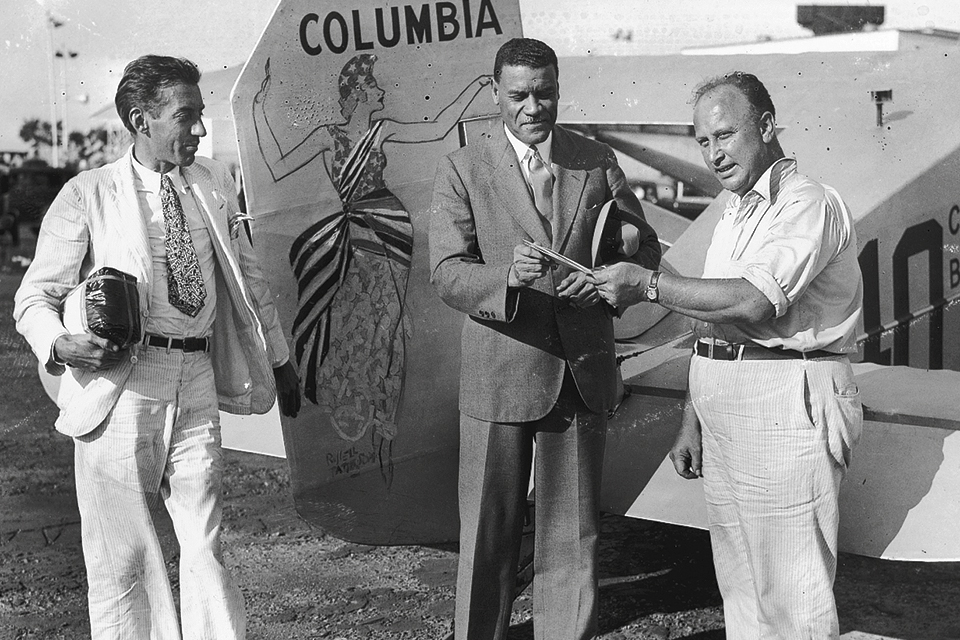
Less than three years later, Erroll Boyd made the first nonstop flight from New York City to Haiti, covering a greater distance than that from Newfoundland to Ireland. Some 5,000 spectators cheered his takeoff from New York in 1933. On his return flight he carried gifts from Haiti’s president to U.S. President Franklin D. Roosevelt. Boyd became the first airman to have two countries issue special stamps for his flights (Canada and Haiti).
Boyd later flew charters out of Miami, where he also became an aviation correspondent. He had attained the rank of captain during World War I, and his friendship with such colorful personalities as war ace Eddie Rickenbacker and racing pilot Roscoe Turner enhanced the popularity of his frequent columns. While serving as an aviation columnist for the Toronto Star Weekly in 1938 he formed the Aviation Scouts of Canada.
Boyd returned to the United States just before World War II. Prior to the Japanese bombing of Pearl Harbor, he became the executive officer for the Clayton Knight Committee in New York, charged with recruiting voluntary ferry pilots for the Canadian war effort. Clayton Knight was an American aviation artist who had served in the Royal Flying Corps during World War I and felt that the United States could not avoid involvement in World War II. The legality of the committee’s activities was questionable because of the U.S. Neutrality Act. The Clayton Knight Committee’s outreach resulted in thousands of pilots’ voluntarily going to Canada and England. Among Boyd’s many recruits were William Alexander, pilot of the first hydroplane flight to Bermuda in 1930; Colonel Joseph C. Mackey, later president of Mackey Airlines of Fort Lauderdale; and Frank Coffyn, an original Wright exhibition pilot who assisted with recruiting from Chicago.
The Clayton Knight Committee, later known as the Canadian Aviation Bureau, was disbanded after Pearl Harbor, and many American pilots came back to the United States. Boyd then became chief test pilot with Higgins Industries, the world’s largest builder of landing craft.
Boyd had supported the idea of a peacetime air force for the League of Nations in the 1930s. He came to question the slaughter of innocent civilians in warfare, and said he felt at times he had more in common with enemy pilots than with diplomats and politicians. Looking back on his war record late in life, Boyd commented: ‘I did not ask these questions in 1915. I was young. I thought I was about to become a hero.’
Erroll Boyd, the quintessential Canadian pilot who later became a U.S. citizen, died in 1960.
This article is adapted from Ross Smyth’s The Lindbergh of Canada: The Erroll Boyd Story (published by General Store Publishing House in Ontario, Canada), which is recommended for further reading.
This article was written by By Ross Smyth and originally published in the November 2000 issue of Aviation History. For more great articles subscribe to Aviation History magazine today!

